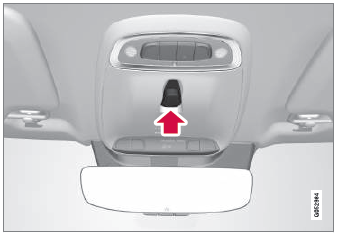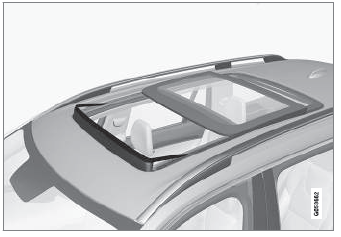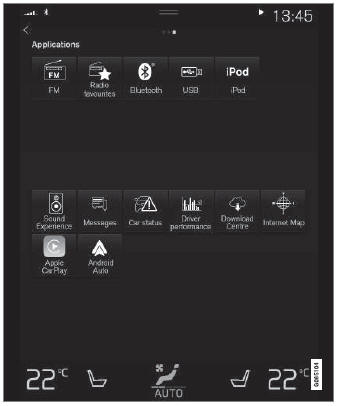Volvo XC90: Lighting / Panoramic roof
(Option/accessory)
The panoramic roof is divided into two glass sections. The front section can be opened vertically at the rear edge (ventilation position) or horizontally (open position). The rear section cannot be moved.
The panoramic roof has a wind deflector and sun curtain made of perforated fabric (located beneath the glass sections) for extra protection in e.g. bright sunlight.

The panoramic roof and sun curtain are operated using the controls in the ceiling.
To operate the panoramic roof and sun curtain, the ignition must be in mode I or II.
WARNING
Children, other passengers or objects can be trapped by the moving parts.
- Always operate the windows with caution.
- Do not allow children to play with the operating controls.
- Never leave a child alone in the vehicle.
- Remember to always cut the current to the power windows by setting the vehicle's electrical system to ignition mode 0 and then taking the key with you when leaving the vehicle.
- Never stick objects or body parts out through the windows, even if the vehicle electrical system is completely turned off.
CAUTION
- Do not open the panoramic roof when load carriers are installed.
- Never place heavy objects on the panoramic roof.
CAUTION
- Remove ice and snow before opening the panoramic roof. Be careful not to scratch any surfaces or damage the trim.
- Do not operate the panoramic roof if it is frozen in place.
Wind blocker

The panoramic roof is equipped with a wind blocker that folds up when the roof is open.
 Adjusting the door mirrors
Adjusting the door mirrors
To improve visibility to the rear, the door mirrors need to be adjusted to
the driver's height and seating position.
There are several automatic settings that can also be connected to the memory
function buttons for the power seat*...
 Operating the panoramic roof
Operating the panoramic roof
(Option/accessory)
The panoramic roof and sun curtain are operated using a control in the ceiling
panel, and both are equipped with pinch protection.
WARNING
Children, other passengers or objects can be trapped by the moving parts...
Other information:
Volvo XC90 2015-2025 Owners Manual: Instrument panel
The instrument panel displays information related to the vehicle and driving. The instrument panel contains gauges, indicators and monitoring and warning symbols. What is shown in the instrument panel varies depending on the equipment, settings and functions currently active...
Volvo XC90 2015-2025 Owners Manual: Using passing assistance
Passing assistance can be used with Adaptive Cruise Control* or Pilot Assist*. Several conditions must be met for passing assistance to be possible. In order to activate passing assistance: your vehicle must be following a vehicle ahead (target vehicle) your vehicle's current speed must be at least 70 km/h (43 mph) the set speed must be high enough to safely pass another vehicle...

